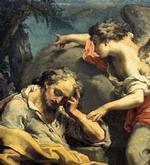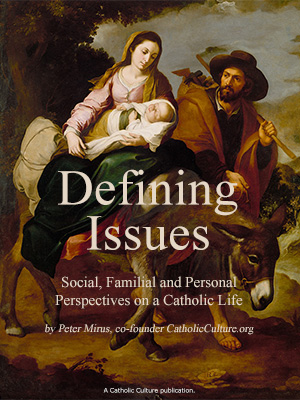Catholic Activity: Corpus Christi Processions
Maria Trapp describes the customs of processions on Corpus Christi in her homeland, Austria.
DIRECTIONS
On the Thursday after the octave of Pentecost falls the feast of Corpus Christi — the feast of the Holy Eucharist. The actual anniversary of the institution of the Blessed Sacrament is celebrated on Holy Thursday, but on this day the Church cannot summon the proper festive mood, because of all the other happenings following the Last Supper, which she also has to commemorate. For this reason she has instituted a special feast day for this event. In the old country this used to be the great feast day at summer's beginning, with its distinctive feature the solemn procession, after the High Mass, in which the Blessed Sacrament was carried through the streets and over the fields and meadows. Such a Corpus Christi Day belongs among our most beautiful memories.
The day before, the big boys of the village cut young trees in the woods, usually birch, and plant them on either side of the road along which the priest will carry the Blessed Sacrament. From the village inn you hear the brass band having a last rehearsal, while mothers pin-curl the hair of their little girls. Everybody is preparing his finery for the great day. The Association of Voluntary Firemen come in their best uniforms and brass helmets. The war veterans will also be in uniform with big plumed hats. The big girls are making garlands by the yards which will span the street. All windows will be decorated, houses and families vying with each other the best carpets, flanked by candles and flowers, are hung out the windows and statues and holy paintings are exhibited on them. Early in the morning freshly cut grass is strewn thickly on the road. Four times the procession will come to a halt, the priest will sing solemnly the beginning of one of the four Gospels and each time there will be Solemn Benediction. At those four spots altars are erected and decorated with trees and greenery and a profusion of flowers and candles. A great deal of love and care and time goes into these preparations.
Then comes the great day. The church choir gives its best at the Solemn High Mass and all the people attend from the mayor to the smallest child, for everybody wants to accompany Our Lord on His triumphal way. The procession is headed by an altar boy carrying a crucifix, followed by all the school children — the girls in white, their veils held in place by wreaths of flowers, looking for all the world like so many little brides; the boys wearing a wreath of flowers on their left upper arm over their Sunday-best, just like "best men." Then come the different confraternities with their banners and costumes. In the towns the convents would send every member they could spare. There would be the blue Vincentian Sisters with their coronets, looking like a group of doves, the white Dominican nuns, the brown Carmelites of the Third Order, the black Benedictines followed by the brown Franciscans, then the Mission Fathers and the bearded Capuchins followed by the secular clergy in their liturgical vestments. They are all like the heralds of the great King Who is following now under the richly embroidered baldachin carried by the four most important men of the community. The pastor carries the monstrance with the Blessed Sacrament. Two little girls are throwing flower petals out of baskets directly at the feet of Our Lord. Little altar boys alternate in ringing silver bells and swinging the censer from which rise billowing clouds, enveloping the Sanctissimum. On the right and on the left are marching soldiers carrying guns as if on parade. Behind the Blessed Sacrament follows the church choir, then a detachment of firemen, the war veterans in uniforms, and the rest of the community. At the very end of the procession comes the brass band playing hymns while everybody joins in the singing. The highlights for everybody, young and old, are the moments of benediction with the priest raising the monstrance for all to see and the soldiers lifting their guns and shooting their salute, while from the outskirts cannons resound with a thundering echo. I cannot remember a single occasion when it rained on Corpus Christi Day. From a cloudless blue sky a hot June sun would shine. At the end of such a triumphal procession everyone from the oldest grandfather in a plumed hat to the smallest flower girl would be in a truly festive mood.
In the new world, we naturally found a different Corpus Christi celebration. In Philadelphia, where we stayed for the first two years, we took part once in a Corpus Christi procession which went around the church grounds. In the second year we acted as church choir at the convent where our little girls went to school, walking around their big garden. It was all very solemn and moving and devout. But as soon as we were up on our hill in Vermont, we obtained the bishop's permission for an outdoor procession. Now we put up two altars, Hedwig cuts the grass early in the morning with a scythe, and all of us accompany Our Lord on His way over the fields and pastures and back home through our cemetery.
Activity Source: Around the Year with the Trapp Family by Maria Augusta Trapp, Pantheon Books Inc., New York, New York, 1955






